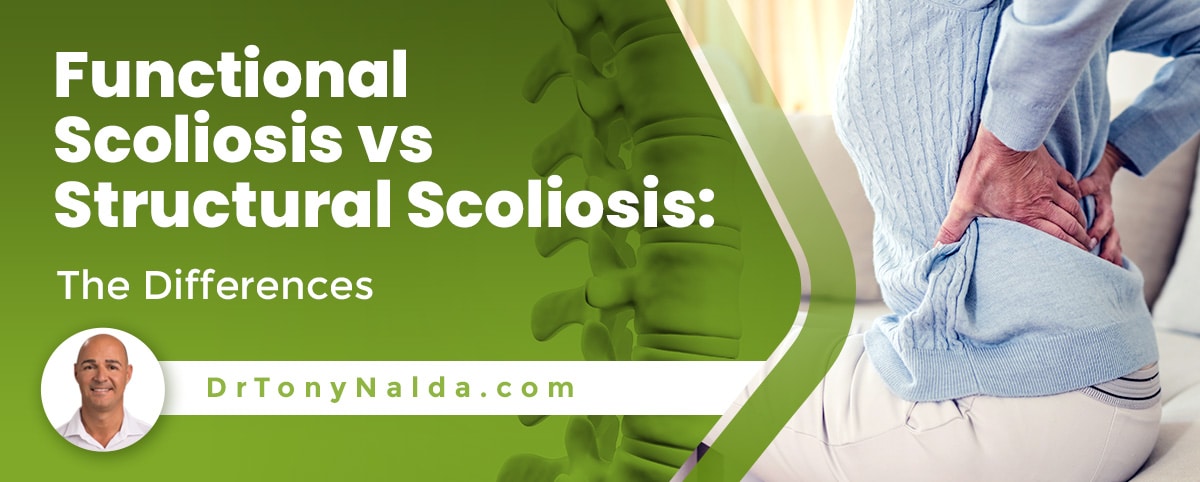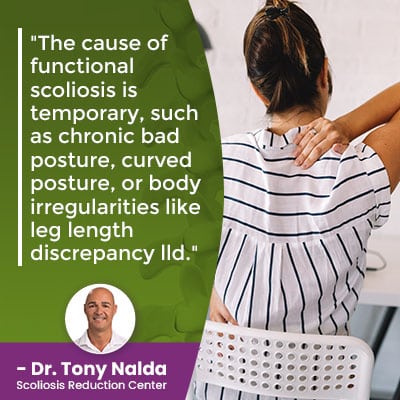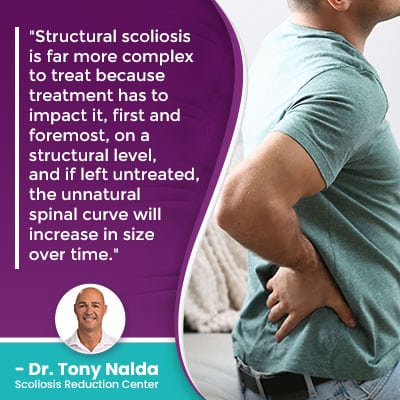Functional Scoliosis vs Structural Scoliosis: The Differences

There is a big difference between what's considered structural scoliosis and functional scoliosis; structural scoliosis is far more complex to treat because it's a structural condition, while functional scoliosis isn't structural so can be addressed with treatment that doesn't have to impact it on a structural level.
In structural scoliosis, there is a structural abnormality within the spine itself; in functional scoliosis, the causes can include chronic poor posture and/or other body irregularities, and can often be corrected through postural remodelling and physical therapy.
Let's also address some key condition characteristics, plus the different types of scoliosis a person can develop, based on their different causes.
Table of Contents
Understanding Scoliosis
When a person is diagnosed with scoliosis, they have developed an unnatural sideways spinal curve, with spinal rotation, and a Cobb angle measurement of at least 10 degrees; this means their spine is no longer aligned.
The spine's natural and healthy curves make it stronger, more flexible, and better able to absorb mechanical stress, so when the spine loses one or more of its healthy curves, its overall health, function, and biomechanics are disrupted.
Scoliosis is Progressive
In addition, scoliosis is a progressive condition, meaning it has it in its very nature to worsen over time, particularly if left untreated.
So where a scoliosis is at the time of diagnosis is not indicative of where it will stay. Even mild scoliosis can progress to moderate, severe, or very-severe scoliosis.
Only proactive treatment can work towards counteracting the condition's progressive nature.
Adolescent Idiopathic Scoliosis
In addition to ranging widely in severity, there are also different condition types a person can develop, and these are classified based on causation.
The most prevalent form of scoliosis is adolescent idiopathic scoliosis, diagnosed between the ages of 10 and 18, which is the form we'll be focusing on throughout the article.
Adolescents are at risk for rapid-phase progression, and this is because the condition's number-one trigger for progression is growth and development, and this age group is in, or entering into, the stage of puberty, characterized by rapid and unpredictable growth spurts.
With my adolescent idiopathic scoliosis patients, the goal of treatment is to reduce the scoliotic curve, or hold it where it is, throughout growth, despite the condition's progressive nature.
I want to prevent progression, escalating scoliosis symptoms, and the need for invasive treatment in the future like spinal fusion surgery.
Scoliosis Surgery is Invasive
Spinal fusion surgery, also known as scoliosis surgery, commonly fuses the unnatural spinal curve's most-tilted vertebrae together into one solid bone; this is done to eliminate movement (progression), in the area.
Often, the spine is held in place by rods attached with screws, and while fusion can help straighten a crooked spine, the way it's achieved can cost the spine in terms of its overall strength, flexibility, and function.
Early Detection is Beneficial
While there are never treatment guarantees, early detection does increase chances of treatment success, when a diagnosis is responded to with proactive treatment.
It's far simpler to treat a scoliotic curve while it's still small, before it has progressed and made the spine more rigid and less responsive to treatment, and before the body has had time to adjust to the unnatural curve's presence; this is why the best time to start treatment is always now, when the condition is at its mildest.
When a condition is diagnosed as mild and responded to with proactive treatment, there are fewer limits to what we can achieve.
Now that we have addressed some key condition characteristics, let's move on to addressing the difference between functional scoliosis and structural scoliosis.
What is Functional Scoliosis?
Also known as nonstructural scoliosis, functional scoliosis is far less prevalent than structural scoliosis.
If a person is diagnosed with functional scoliosis, they can present with an unnatural sideways spinal curvature, but there will be no rotational component, meaning the spine won't twist from back to front, front to back, and the actual structure of the spine will be typical.
 The cause of functional scoliosis is temporary, such as chronic bad posture, curved posture, or body irregularities like leg length discrepancy lld.
The cause of functional scoliosis is temporary, such as chronic bad posture, curved posture, or body irregularities like leg length discrepancy lld.
When patients with functional scoliosis change from standing position to lying down or bending forward, the scoliotic curve will likely go away in response to the body's changing position; with structural scoliosis, no change in position can make the unnatural curve go away.
Functional Scoliosis Treatment
When a patient's functional scoliosis is caused by leg length discrepancy, or chronic bad posture, this can generally be treated by addressing any postural issues through custom-prescribed exercises and stretches (physical therapy) known to correct bad posture, address muscle imbalance, increase core strength, and elongate the spine.
When leg length discrepancy lld is the cause, this is often addressed with the prescription of custom orthotics or insoles (internal shoe lift) that corrects the leg length discrepancy, which takes pressure off the spine so its normal curves and alignment can be restored.
What's Structural Scoliosis?
Structural scoliosis is considered a true scoliosis and is the most prevalent type.
In addition to the unnatural sideways spinal curve, structural scoliosis means there is spinal rotation present, making the condition 3-dimensional, and this type of scoliosis impacts the spine's structure, function, and is considered permanent, especially if left untreated.
Condition severity is determined by a patient's Cobb angle, and the higher the Cobb angle, the more severe the condition:
- Mild scoliosis: Cobb angle measurement of between 10 and 25 degrees
- Moderate scoliosis: Cobb angle measurement of between 25 and 40 degrees
- Severe scoliosis: Cobb angle measurement of 40+ degrees
- Very-severe scoliosis: Cobb angle measurement of 80+ degrees
 Structural scoliosis is far more complex to treat because treatment has to impact it, first and foremost, on a structural level, and if left untreated, the unnatural spinal curve will increase in size over time.
Structural scoliosis is far more complex to treat because treatment has to impact it, first and foremost, on a structural level, and if left untreated, the unnatural spinal curve will increase in size over time.
In addition, there are also different types of structural scoliosis, based on different causes.
Types of Structural Scoliosis
When scoliosis is diagnosed, part of the process involves comprehensively assessing conditions so they can be further classified based on key patient/condition variables, and one such classification point is type, determined by cause.
Idiopathic Scoliosis
The most prevalent form of scoliosis, as mentioned, is adolescent idiopathic scoliosis, and as idiopathic scoliosis is also the most common type to affect adults, idiopathic scoliosis is the most common category of scoliosis, accounting for approximately 80 percent of known diagnosed cases, and the remaining 20 percent are associated with known causes.
Idiopathic scoliosis means not clearly associated with a single causative source; clear causative sources are neuromuscular, degenerative, traumatic, and congenital scoliosis.
Neuromuscular Scoliosis
Neuromuscular scoliosis affects people as a secondary complication caused by a larger neuromuscular condition such as cerebral palsy, muscular dystrophy, or spina bifida, to name a few.
In these types of neuromuscular conditions, there is a disconnect between the brain and muscles and/or connective tissues that support the spine.
This type is considered atypical because the underlying cause of the scoliosis is the presence of a larger neuromuscular condition, complicating the treatment process
Degenerative Scoliosis
Degenerative scoliosis affects adults as they age and is caused by natural age-related spinal degeneration that commonly affects the discs and joints of the spine.
The condition is more prevalent in women than men, and this is related to bone density and hormone changes caused by menopause.
After idiopathic scoliosis, degenerative scoliosis is the most common type to affect adults.
Traumatic Scoliosis
Traumatic scoliosis is a rare type and is caused by the spine experiencing a significant trauma, such as in a car accident or fall.
Traumatic scoliosis can also be caused by the presence of tumors pressing on the spine that force it out of alignment.
Congenital Scoliosis
Congenital scoliosis develops in utero as a malformation develops within the spine, and infants are born with the condition.
Congenital scoliosis is another rare form, affecting approximately 1 in 10,000 infants.
Bone malformations can include vertebrae that are more triangular in shape, when they are supposed to be rectangular so they can be easily stacked on top of one another to stay straight and in alignment.
In addition, vertebrae can also fail to form into separate and distinct vertebral bodies, becoming fused together instead.
Conclusion
When it comes to addressing the main difference between functional scoliosis and structural scoliosis, we're talking about a temporary cause for a temporary spinal curve, versus a structural issue within the spine itself that's considered permanent.
True scoliosis is structural in nature, and 3-dimensional, because of its rotational component, which is why treatment has to impact it on a structural level.
Because scoliosis is progressive, treatment has to be proactive in an effort to stay ahead of a condition's progressive line, and in addition, it's far simpler to treat scoliosis while mild, before it's been left to progress.
In cases of functional scoliosis, this presents as an unnatural spinal curve, but it's not structural in nature, making it temporary and far simpler to treat.
Here at the Scoliosis Reduction Center, for my structural scoliosis patients, I integrate multiple condition-specific treatment disciplines such as chiropractic care, physical therapy, corrective bracing, and custom-prescribed home exercises for the best potential treatment results that preserve as much of the spine's natural function as possible.
Dr. Tony Nalda
DOCTOR OF CHIROPRACTIC
After receiving an undergraduate degree in psychology and his Doctorate of Chiropractic from Life University, Dr. Nalda settled in Celebration, Florida and proceeded to build one of Central Florida’s most successful chiropractic clinics.
His experience with patients suffering from scoliosis, and the confusion and frustration they faced, led him to seek a specialty in scoliosis care. In 2006 he completed his Intensive Care Certification from CLEAR Institute, a leading scoliosis educational and certification center.
About Dr. Tony Nalda
 Ready to explore scoliosis treatment? Contact Us Now
Ready to explore scoliosis treatment? Contact Us Now





